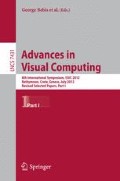Abstract
Robust Principal Components Analysis (RPCA) gives a suitable framework to separate moving objects from the background. The background sequence is then modeled by a low rank subspace that can gradually change over time, while the moving objects constitute the correlated sparse outliers. RPCA problem can be exactly solved via convex optimization that minimizes a combination of the nuclear norm and the l 1-norm. This convex optimization is commonly solved by an Alternating Direction Method (ADM) that is not applicable in real application, because it is computationally expensive and needs a huge size of memory. In this paper, we propose to use a Linearized Symmetric Alternating Direction Method (LSADM) to achieve RPCA for moving object detection. LSADM in its fast version requires less computational time than ADM. Experimental results on the Wallflower and I2R datasets show the robustness of the proposed approach.
Access this chapter
Tax calculation will be finalised at checkout
Purchases are for personal use only
Preview
Unable to display preview. Download preview PDF.
References
Bouwmans, T.: Recent advanced statistical background modeling for foreground detection: A systematic survey. RPCS 4, 147–176 (2011)
Oliver, N., Rosario, B., Pentland, A.: A bayesian computer vision system for modeling human interactions. In: ICVS 1999 (1999)
Bouwmans, T.: Subspace learning for background modeling: A survey. RPCS 2, 223–234 (2009)
Torre, F.D.L., Black, M.: A framework for robust subspace learning. International Journal on Computer Vision, 117–142 (2003)
Candes, E., Li, X., Ma, Y., Wright, J.: Robust principal component analysis? International Journal of ACM 58 (2011)
Wright, J., Peng, Y., Ma, Y., Ganesh, A., Rao, S.: Robust principal component analysis: Exact recovery of corrupted low-rank matrices by convex optimization. In: NIPS 2009 (2009)
Lin, Z., Ganesh, A., Wright, J., Wu, L., Chen, M., Ma, Y.: Fast convex optimization algorithms for exact recovery of a corrupted low-rank matrix. UIUC Technical Report (2009)
Lin, Z., Chen, M., Wu, L., Ma, Y.: The augmented lagrange multiplier method for exact recovery of corrupted low-rank matrices. UIUC Technical Report (2009)
Yuan, X., Yang, J.: Sparse and low-rank matrix decomposition via alternating direction methods. Optimization Online (2009)
Ma, S.: Algorithms for sparse and low-rank optimization: Convergence, complexity and applications. Thesis (2011)
Goldfarb, D., Ma, S., Scheinberg, K.: Fast alternating linearization methods for minimizing the sum of two convex function. Preprint, Mathematical Programming Series A (2010)
Wren, C., Azarbayejani, A., Darrell, T., Pentland, A.: Pfinder: Real-time tracking of the human body. IEEE Transactions on PAMI 19, 780–785 (1997)
Stauffer, C., Grimson, W.: Adaptive background mixture models for real-time tracking. In: CVPR 1999, pp. 246–252 (1999)
Toyama, K., Krumm, J., Brumitt, B., Meyers, B.: Wallflower: Principles and practice of background maintenance. In: ICCV 1999, pp. 255–261 (1999)
Li, L., Huang, W., Gu, I., Tian, Q.: Statistical modeling of complex backgrounds for foreground object detection. IEEE T-IP, 1459–1472 (2004)
Maddalena, L., Petrosino, A.: A fuzzy spatial coherence-based approach to background foreground separation for moving object detection. Neural Computing and Applications, 1–8 (2010)
Author information
Authors and Affiliations
Editor information
Editors and Affiliations
Rights and permissions
Copyright information
© 2012 Springer-Verlag Berlin Heidelberg
About this paper
Cite this paper
Guyon, C., Bouwmans, T., Zahzah, EH. (2012). Moving Object Detection by Robust PCA Solved via a Linearized Symmetric Alternating Direction Method. In: Bebis, G., et al. Advances in Visual Computing. ISVC 2012. Lecture Notes in Computer Science, vol 7431. Springer, Berlin, Heidelberg. https://doi.org/10.1007/978-3-642-33179-4_41
Download citation
DOI: https://doi.org/10.1007/978-3-642-33179-4_41
Publisher Name: Springer, Berlin, Heidelberg
Print ISBN: 978-3-642-33178-7
Online ISBN: 978-3-642-33179-4
eBook Packages: Computer ScienceComputer Science (R0)

